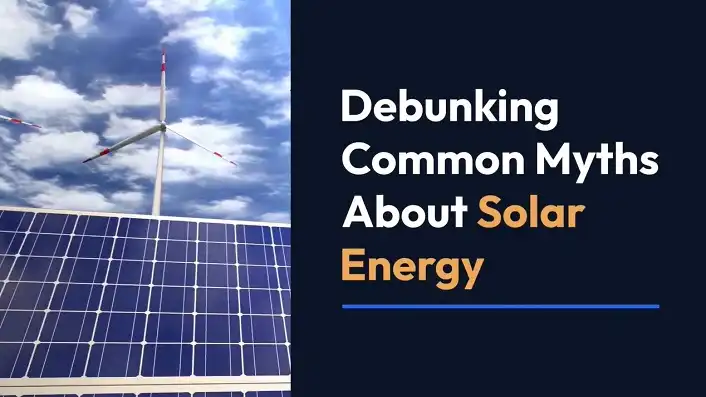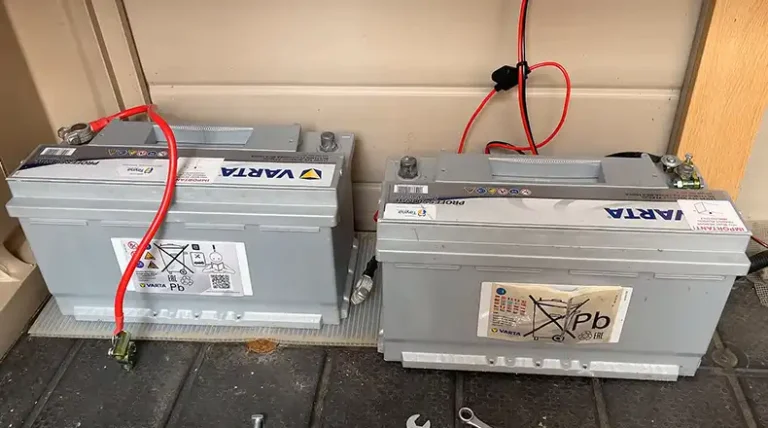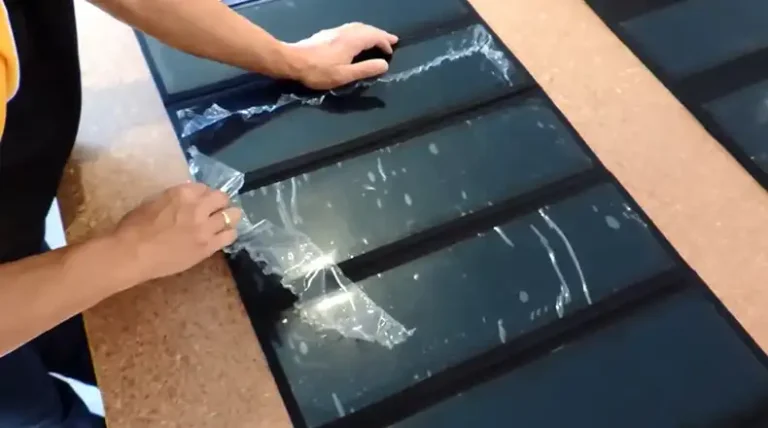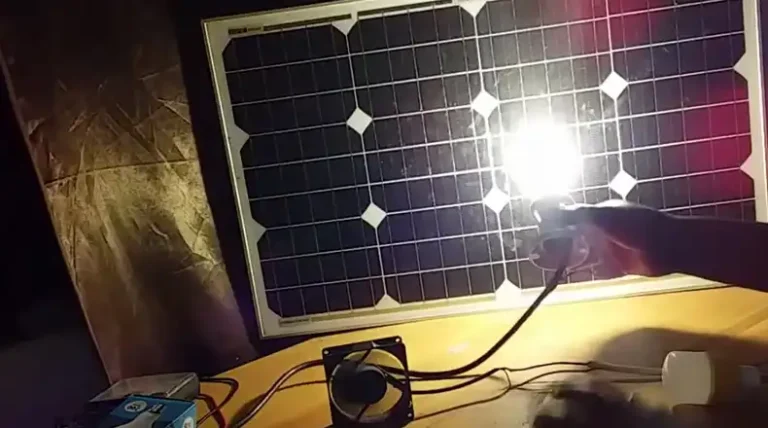21 Common Myths And Misconceptions About Solar Energy Debunked

As solar energy continues to gain popularity as a sustainable and cost-effective power solution, it’s important to separate fact from fiction.
Despite the growing adoption of solar technology, numerous myths and misconceptions still persist, potentially holding back even greater implementation of this clean energy source.
In this article, we’ll debunk some of the most common myths about solar energy to provide clarity and help you make informed decisions about adopting solar power for your home or business.
From concerns about efficiency in various weather conditions to questions about cost and maintenance, we’ll address the top misconceptions surrounding solar energy.
By examining the facts and dispelling these myths, we aim to shed light on the true potential of solar power as a reliable, affordable, and environmentally friendly energy solution.
Whether you’re considering solar panels for your property or simply curious about renewable energy options, this guide will provide you with accurate information to better understand the realities of solar energy in today’s world.
Debunking 21 Common Solar Energy Myths
Let’s take a closer look at some of the most prevalent myths about solar energy and uncover the truth behind them.
Myth 1: Solar Panels Don’t Work In Cloudy Or Cold Weather
One of the most persistent myths about solar energy is that solar panels are only effective in sunny, warm climates.
This misconception often leads people in cloudier or colder regions to dismiss solar power as a viable option for their homes or businesses.
The Reality
While it’s true that solar panels perform best in direct sunlight, they can still generate electricity on cloudy days and in colder temperatures.
Solar panels rely on light, not heat, to produce electricity. Even on overcast days, panels can capture diffused sunlight and convert it into usable energy.
In fact, some solar panel technologies are designed to perform efficiently in low-light conditions. Additionally, colder temperatures can actually improve the efficiency of solar panels, as excessive heat can reduce their performance.
Myth 2: Solar Energy Is Too Expensive
Another common misconception is that solar energy is prohibitively expensive and only accessible to wealthy individuals or businesses. This belief often stems from outdated information about the cost of solar technology.
The Reality
The cost of solar panels and installation has decreased significantly in recent years, making solar energy more affordable and accessible than ever before.
According to the World Economic Forum, prices have dropped by more than 80% in the last decade.
While the upfront costs of installing a solar system can be substantial, there are various financing options, tax incentives, and rebates available to help offset the initial investment.
Many homeowners and businesses find that the long-term savings on energy bills make solar a cost-effective choice in the long run.
Moreover, programs like net metering allow solar system owners to sell excess energy back to the grid, further reducing their electricity costs and improving the return on investment.
Myth 3: Solar Panels Require High Maintenance
Some people believe that solar panels are high-maintenance systems that require frequent cleaning, repairs, and replacements. This myth can deter potential adopters who are concerned about the ongoing care of their solar installation.
The Reality
Solar panels are actually relatively low-maintenance systems. They have no moving parts, which reduces the risk of mechanical failures. Most solar panels are designed to be durable and withstand various weather conditions.
While occasional cleaning may be necessary to remove dust or debris that could affect efficiency, this is typically a simple process that can be done with water or a soft brush. In many cases, rain can naturally clean the panels.
Most solar panel systems come with warranties of 25 to 30 years, indicating their long-term reliability. Regular inspections can help ensure optimal performance, but these are generally infrequent and straightforward.
Myth 4: Solar Energy Is Unreliable
Some skeptics argue that solar energy is inconsistent and unreliable due to its dependence on weather conditions and the fact that it doesn’t generate power at night.
The Reality
While it’s true that solar panels don’t produce electricity at night, advancements in solar technology and energy storage solutions have greatly improved the reliability of solar energy systems.
Modern solar installations often include battery storage systems that can store excess energy generated during the day for use during nighttime or cloudy periods.
Additionally, most residential and commercial solar systems remain connected to the traditional power grid, ensuring a constant supply of electricity even when solar production is low.
Grid-tied systems also allow for net metering, where excess energy produced by solar panels can be fed back into the grid for credits, which can be used when the solar system isn’t producing enough power to meet demand.
Myth 5: Solar Panels Damage Roofs
There’s a common concern that installing solar panels can cause damage to roofs, leading to leaks or structural issues.
The Reality
When properly installed by experienced professionals, solar panels do not damage roofs.
In fact, they can actually provide an additional layer of protection for the portion of the roof they cover, shielding it from the elements and potentially extending its lifespan.
Reputable solar installers will assess the condition and structural integrity of a roof before installation to ensure it can support the weight of the panels.
They use specialized mounting systems designed to securely attach the panels without compromising the roof’s structure or waterproofing.
In many cases, solar panels are installed on a racking system that doesn’t directly penetrate the roof, further reducing the risk of damage.
If roof repairs or replacements are needed in the future, solar panels can be temporarily removed and reinstalled.
Myth 6: Solar Panels Only Work In Sunny Climates
This myth is closely related to the first one, but it’s worth addressing separately as it’s a common reason why people in certain geographical areas dismiss solar energy as an option.
The Reality
While sunny climates may produce more solar energy, solar panels can be effective in a wide range of climates and geographical locations.
Countries like Germany, which isn’t known for its sunny weather, have successfully implemented large-scale solar energy programs.
Solar panels can generate electricity from both direct and indirect sunlight. Even in cloudier regions, the cumulative energy production over time can be substantial.
Additionally, some types of solar panels are specifically designed to perform well in low-light conditions.
It’s also worth noting that extremely hot climates can actually reduce solar panel efficiency, so moderate climates may see more consistent performance throughout the year.
Myth 7: Solar Panels Decrease Property Value
Some homeowners worry that installing solar panels will make their property less attractive to potential buyers if they decide to sell in the future.
The Reality
Contrary to this belief, studies have shown that homes with solar panel systems often sell for more than comparable homes without solar.
According to a study by Zillow, homes with solar panels sold for 4.1% more on average than similar homes without solar power.
As energy costs continue to rise and environmental concerns become more prevalent, many homebuyers see solar panels as a valuable asset.
They represent potential long-term savings on energy bills and appeal to environmentally conscious consumers.
However, it’s important to note that the impact on property value can depend on factors such as the quality of the installation, the efficiency of the system, and local real estate market conditions.
Myth 8: Solar Energy Production Is Harmful To The Environment
While solar energy is often touted as a clean, renewable energy source, some critics argue that the production of solar panels is environmentally harmful and offsets the benefits of solar power.
The Reality
It’s true that the production of solar panels does have some environmental impact, primarily due to the energy-intensive manufacturing process and the use of certain materials.
However, the long-term environmental benefits of solar energy far outweigh these initial impacts. Solar panels produce clean, emissions-free electricity for decades once installed.
The energy payback time – the time it takes for a solar panel to produce as much energy as was used in its production – is typically 1-4 years, depending on the type of panel and its location.
Given that solar panels can last 25-30 years or more, they produce clean energy for many years beyond their energy payback period.
Moreover, the solar industry is continually working to improve manufacturing processes and reduce the environmental impact of production. Recycling programs for old solar panels are also being developed to address end-of-life concerns.
Myth 9: Solar Panels Take Up Too Much Space
Some people believe that solar installations require vast amounts of space, making them impractical for residential or urban use.
The Reality
While the space requirements for solar panels can vary depending on the energy needs and the efficiency of the panels, most residential solar systems can be comfortably installed on the roof of a home without taking up additional space.
For an average home, a solar system that can offset a significant portion of electricity usage typically requires about 400-600 square feet of roof space.
Many modern homes have sufficient roof area to accommodate this. For those with limited roof space or for larger energy needs, there are alternative installation options.
These include ground-mounted systems, solar carports, or even newer technologies like solar roof tiles that integrate seamlessly with traditional roofing materials.
Myth 10: Solar Eliminates Electricity Bills Completely
Some people have the misconception that once they install solar panels, they’ll never have to pay an electricity bill again.
The Reality
While solar panels can significantly reduce or even eliminate your electricity bills in some cases, it’s important to have realistic expectations. The extent to which solar can offset your electricity costs depends on several factors, including:
- The size of your solar system
- Your energy consumption habits
- Local weather patterns
- Your utility’s policies (such as net metering)
Most residential solar systems are designed to offset a large portion of a home’s electricity usage, but not necessarily 100%.
Many homeowners still maintain a connection to the grid for times when their solar production doesn’t meet their energy needs, such as at night or during extended cloudy periods.
Additionally, some utilities charge a minimum monthly fee for grid connection, even if you’re producing all of your own electricity.
However, even with these considerations, the savings on electricity bills over the life of a solar system can be substantial.
Certainly! I’ll add 11 more myths to the existing 10, expanding our list to cover 21 common misconceptions about solar energy. Here are the additional myths:
Myth 11: Solar Panels Don’t Work At Night
Solar panels are only effective during daylight hours, rendering them useless at night. This misconception suggests that homeowners would be left without power after the sun sets.
The Reality:
While it’s true that solar panels don’t generate electricity at night when there’s no sunlight, this doesn’t mean a solar-powered home is without electricity after dark.
Most residential solar systems are connected to the power grid, allowing homeowners to draw electricity from the grid when their panels aren’t producing.
Additionally, many systems now incorporate battery storage, which can store excess energy produced during the day for use at night.
Myth 12: You Can’t Add Solar Panels To An Existing Home
The idea that solar panels can only be installed on newly constructed homes is false. Many homeowners believe that retrofitting an existing house with solar panels is impractical or impossible.
The Reality:
Solar panels can be installed on most existing homes. While it’s easiest to incorporate solar during new construction, retrofitting an existing home for solar is a common practice.
Professional installers can assess your roof’s condition, orientation, and shading to determine the best setup for your home. If roof installation isn’t feasible, ground-mounted systems are another option for existing homes.
Myth 13: All Solar Panels Are The Same
This myth implies that all solar panels are identical in terms of efficiency, durability, and appearance. It overlooks the diverse range of technologies and qualities available in the market.
The Reality:
There’s significant variation in solar panel quality, efficiency, and design. Different types of solar cells (monocrystalline, polycrystalline, and thin-film) have different efficiencies and aesthetics.
Additionally, panels vary in their power output, durability, and warranty terms. It’s important to research and choose panels that best fit your specific needs and budget.
Myth 14: Solar Panels Will Make Your Home Go Off-Grid
Some people mistakenly believe that embracing solar energy requires complete independence from the traditional power grid. This misconception often deters homeowners from considering solar as an option.
The Reality:
While it’s possible to design an off-grid solar system, most residential solar installations are grid-tied.
This means your home remains connected to the utility grid, allowing you to draw power when needed and potentially sell excess power back to the grid.
Completely off-grid systems require significant battery storage and careful energy management, which isn’t necessary or practical for most homeowners.
Myth 15: Solar Panels Are Unattractive And Will Ruin Your Home’s Appearance
This myth portrays solar panels as unattractive and disruptive to a home’s aesthetic appeal, deterring homeowners from considering solar installations due to concerns about property value.
The Reality:
Solar panel aesthetics have improved significantly over the years. Many modern panels have a sleek, low-profile design that can complement a home’s appearance.
For those particularly concerned about aesthetics, there are now solar roof tiles and other building-integrated photovoltaic products that blend seamlessly with traditional roofing materials.
Myth 16: You Need To Live In A Warm Climate For Solar To Be Worth It
This misconception suggests that solar energy is primarily suitable for regions with abundant sunshine and warm climates, limiting its potential for widespread adoption.
The Reality:
While sunny, warm climates can produce more solar energy, solar panels can be effective in a wide range of climates. In fact, solar panels often perform better in cooler temperatures.
Countries like Germany, which isn’t known for its sunny weather, have successfully implemented large-scale solar energy programs. The key factor is the amount of sunlight, not heat.
Myth 17: Solar Panels Are Fragile And Easily Damaged
This myth falsely portrays solar panels as fragile and susceptible to damage from weather conditions, raising concerns about their reliability and longevity.
The Reality:
Solar panels are designed to withstand a variety of weather conditions, including hail, heavy rain, and snow. Most panels undergo rigorous testing and are certified to withstand winds of up to 140 mph and golf ball-sized hail.
While they’re not indestructible, solar panels are far more durable than many people assume.
Myth 18: Solar Technology Isn’t Advanced Enough Yet
This misconception implies that solar technology is still in its infancy and not yet mature enough for practical application. It underestimates the rapid advancements and widespread adoption of solar energy.
The Reality:
Solar technology has made significant advancements in recent years and continues to improve. Today’s solar panels are more efficient, durable, and affordable than ever before.
While future improvements are certainly possible, current solar technology is already highly effective and economically viable for many homeowners and businesses.
19: Solar Panels Contain Hazardous Materials And Are Bad For The Environment
This myth falsely claims that solar panel production and disposal harm the environment due to the use of hazardous materials. It overlooks the overall environmental benefits of solar energy compared to traditional power sources.
The Reality:
While it’s true that solar panels contain some potentially hazardous materials, these are safely encapsulated within the panel during normal use.
The environmental benefits of solar energy far outweigh the potential risks. Moreover, the solar industry is developing recycling programs to safely handle panels at the end of their life cycle, further minimizing environmental impact.
Myth 20: You Can’t Sell Excess Energy Back To The Grid
This misconception suggests that homeowners cannot benefit financially from installing solar panels, as they cannot sell excess electricity back to the grid.
The Reality:
Many utilities offer net metering programs, which allow solar system owners to sell excess energy back to the grid.
This can significantly enhance the economic benefits of solar by providing credit for energy produced beyond what the home uses. While policies vary by location, the ability to sell excess energy is a reality in many areas.
Myth 21: Solar Panels Will Become Obsolete Quickly
This myth implies that solar panel technology is rapidly evolving, rendering current installations obsolete. It discourages homeowners from investing in solar energy due to concerns about short-term return on investment.
The Reality:
Solar technology does continue to improve, but this doesn’t mean current panels will become obsolete. Most solar panels are designed to produce electricity efficiently for 25-30 years or more.
While newer panels might be incrementally more efficient, the panels you install today will continue to generate valuable electricity for decades.
Additionally, many improvements in solar technology focus on manufacturing processes and costs rather than radical changes to the panels themselves
Conclusion
As we’ve explored in this article, many of the common myths about solar energy are based on outdated information or misunderstandings about how solar technology works.
The reality is that solar energy has become an increasingly viable and attractive option for homeowners and businesses alike.
From its ability to function in various weather conditions to its positive impact on property values, solar energy offers numerous benefits.
While it’s true that solar installations require an initial investment, the long-term savings, coupled with environmental benefits, make it a compelling choice for many.





![[Explored] What Are the Drawbacks to Solar Tube Lighting?](https://www.itekenergy.com/wp-content/uploads/2023/07/What-Are-the-Drawbacks-to-Solar-Tube-Lighting-768x428.webp)
